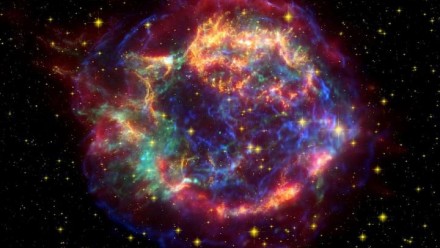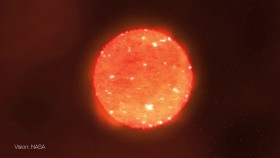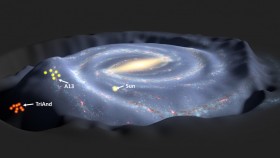The mysterious case of the missing isotopes
ANU ScienceWise magazine - Autumn 2012
Our solar system condensed from the protoplanetary disc that surrounded the newly forming sun. So it makes sense that the basic building blocks that created the Sun are the same as those for the Earth. However, it’s actually quite a difficult hypothesis to test because there’s no way for scientists to retrieve samples of the sun for laboratory analysis. Instead, the abundance of heavy elements in the sun has to be measured using remote spectroscopy, which is good for some elements but useless for many others.
However what we do have access to are meteorites and lots of them. Such space rocks formed when the dust and debris orbiting the Sun coalesced under gravity to create larger and larger lumps of material. When some of these lumps became large enough, the gravitational pressure at the centre compressed the material into various minerals. Subsequent collisions then smashed these large rocky bodies to pieces leaving the early solar system littered with rocky fragments which form the majority of meteorites that fall on the Earth today.
One type of meteorite of particular interest to science are chondrites. These are fragments of objects that were large enough to compress into rock but not so large that the material within them separated into a core and mantle. As such, Chondrites provide perfect samples of the material that formed the early solar system and they’re regularly delivered right to our doorstep.
For many years scientists have been examining the elements found in chondrites and measuring their isotopic ratio, which forms a sort of chemical signature. Now if the entire solar system was created from the same material, one would expect the isotopic ratio of chondrites to be exactly the same as that of ordinary rocks on the Earth. But it’s not.
The discrepancy is significant for many elements including samarium, neodymium and also the argon that is produced from the radioactive decay of an isotope of potassium. For example, the Earth’s atmosphere has only half the argon that chondrite analysis would suggest and the rocks of the upper mantle contain a significantly different ratio of samarium and neodymium isotopes too.
This has puzzled scientists for many years. The accepted textbook explanation is that trapped somewhere deep within the Earth, must be a layer of early crust that contains the right isotope ratio to make the samarium/ neodymium isotope results add up.
However recent work by two geoscientists at the ANU has called all of this into question. Professors Hugh O’Neill and Ian Campbell have developed an elegant alternative theory.
Elements like samarium and neodymium are, from a geochemical perspective, very similar to elements like uranium thorium and potassium. The upshot of this is that they tend to concentrate in the same places. And the thing about these heavy radioactive elements is that they undergo decay, which produces heat and lots of it.
This heat escapes from the core mantle/boundary deep in the Earth in what are known as mantle plumes. Huge up-spouts of convecting rock that ultimately surface in volcanos such as those of the Hawaiian-Emperor seamount chain.
These particular volcanos are odd in that they are not associated with plate tectonic activity - being far from any plate boundary. Their cones essentially pop up directly above the mantle plume so that as the moving plate slides beneath them a chain of volcanic mountains is formed.
“If we calculate the absolute maximum heat that these mantle plumes could bring to the surface it accounts for less than half that which would be generated by a hidden reservoir big enough to explain the samarium/ neodymium ratio.” Professor Campbell says. “You might be able to hide the isotopes but you can’t hide the heat!”
Professor O’Neill’s alternative theory is that this isotope difference is explained by collisional erosion and it goes something like this: Once the small planetary bodies than eventually formed the Earth reached about one quarter the size of the present Earth, they formed an early crust that had a different composition and different isotopic ratio to the rest of the planet. Much of this crust material was then blown into space by the impacts of these moderate sized planetary bodies, leaving the remaining Earth depleted in uranium, thorium and potassium and changing the ratio of certain isotopes including samarium and neodymium.
Every night you can see the evidence that such things do happen. Our Moon was probably formed from material ejected when a Mars sized body smashed into the Earth. So the notion of impact ejecting lighter rocky material from planets is well established.
“If you basically abandon the idea of hidden isotope reservoirs and think of Earth’s early composition being significantly modified by massive space impacts nearly all of the anomalies and paradoxes simply go away” Professor O’Neill says.












